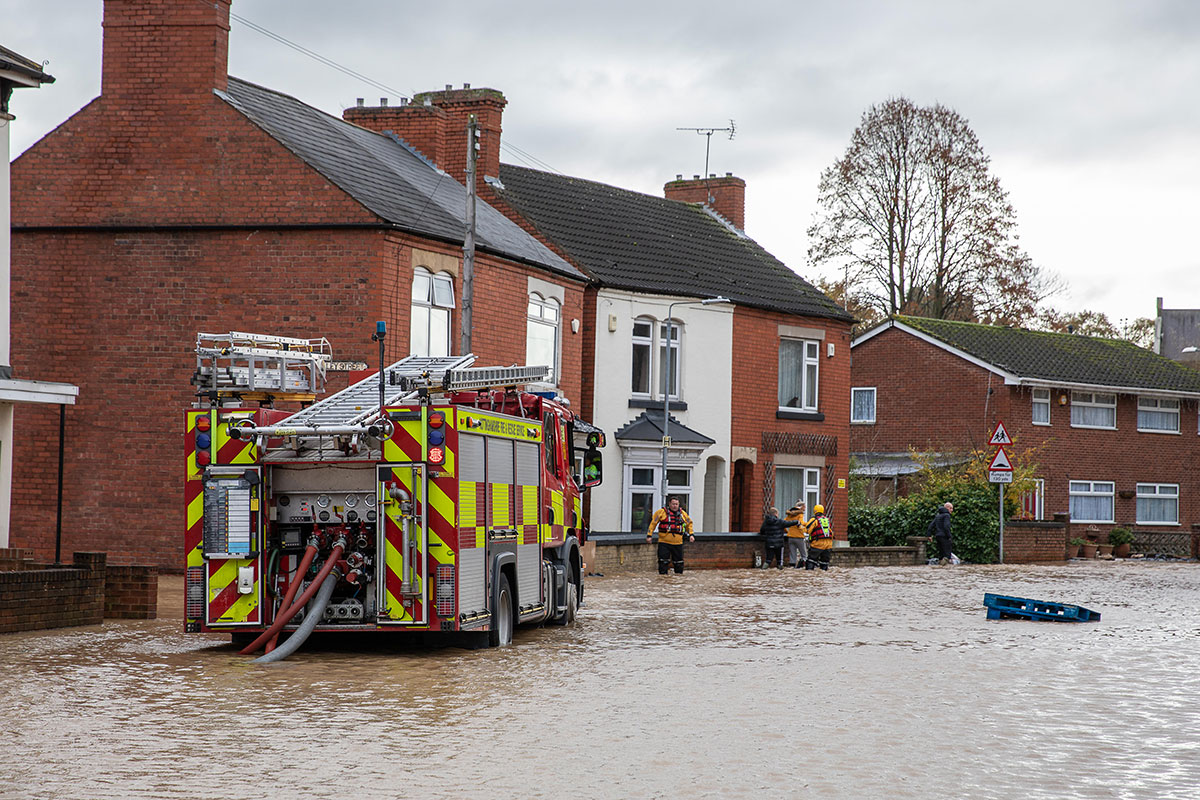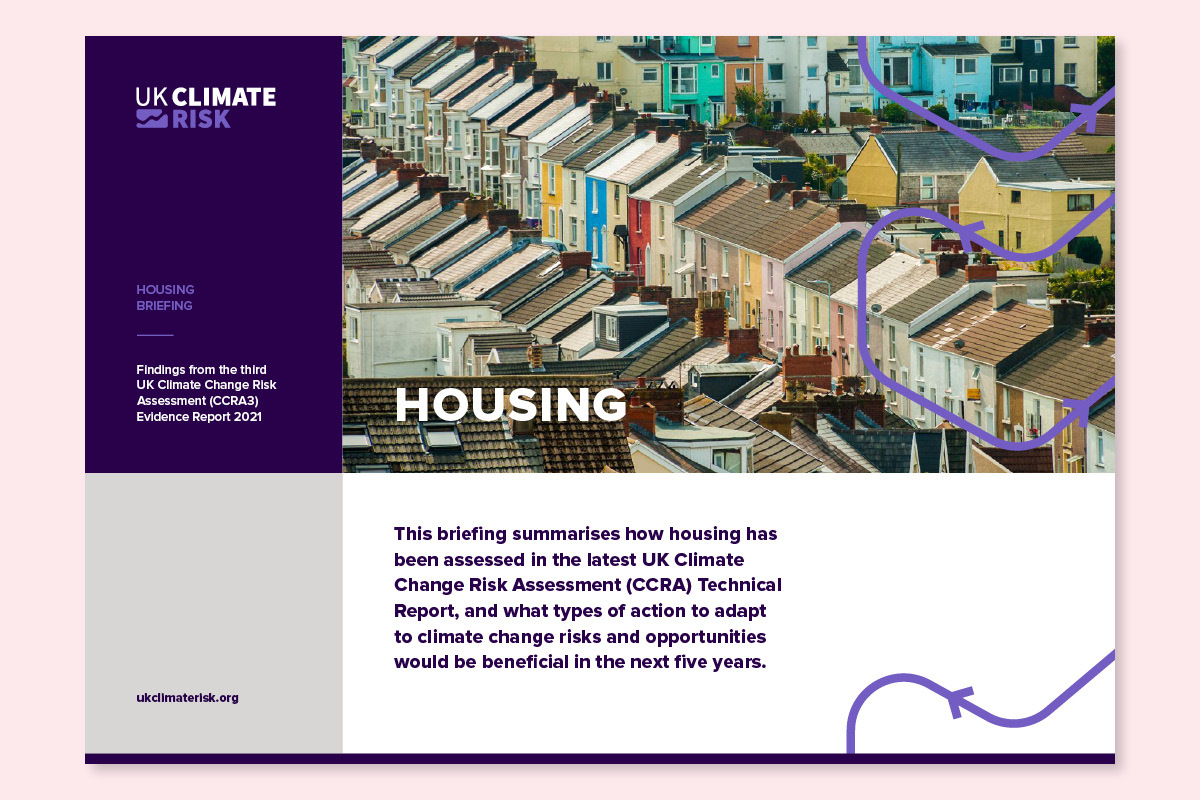How to protect tenants and buildings from climate change
We know to expect more heatwaves and flooding due to climate change, and we know that it will impact tenants. But how are social landlords preparing to mitigate those challenges? Eve Livingston looks at the options available – and whether landlords are doing this work

When the UK’s hottest-ever temperatures were recorded in July this year, many pointed out that the extreme heat was not just a fluke but part of a predictable pattern of warming caused by climate change. Like industries across the UK, the social housing sector has worked in recent years to make progress on areas such as carbon emissions and sustainability measures, but record-breaking temperatures showed the importance of also planning for the impacts of climate change that are already baked into the country’s future.
“When we talk about things like overheating and flooding, we’re talking about people’s lives and the real misery that’s caused,” says Richard Lupo, managing director at SHIFT Environment, a sustainability consultancy firm for building owners. “And the projections are getting worse: hotter summers and more intense flood events. Landlords are facing many pressures but these are assets that people live in and so they need to be acting now.”
Climate resilience in the context of social housing can encompass many initiatives but may include, for example, planning for increasing and extreme temperatures; protecting homes against flooding; preparing for pressure on water supply; and preserving biodiversity, which can reduce the impact of these threats. While some housing associations include actions on climate resilience as part of their environmental, social and governance (ESG) reporting for investors, there are currently few formalised measures or standards, Mr Lupo says.
“At the moment, it seems like there’s nobody holding anyone to account on this,” he says, pointing out that 2020’s Social Housing White Paper noted the importance of making homes climate resilient, but this has not yet been translated into specific measures in England’s Decent Homes Standard.
“As far as we can tell, there are no metrics to be reported [in the Decent Homes Standard] on overheating, flood, biodiversity or water stress. There isn’t the same agenda as there is with something like net zero,” says Mr Lupo.
Some social landlords are starting to plan for events such as flooding and extreme temperatures in the building of new developments, where some of these actions are incentivised in building standards or planning policies. A challenge remains, however, when it comes to protecting tenants in existing homes. July’s heatwave saw housing associations provide temporary measures such as fans and cold water, but to adapt properties for the long term would require costly and time-intensive retrofitting.
“The cost of intervention is significant, but arguably the cost of inaction is greater,” says Adam Masters, assistant director of environment and sustainability at 34,250-home housing association Stonewater. “Recent events have demonstrated that the effects of climate change already pose a great risk to our customers and our homes.”
A number of Stonewater’s tenants were affected by flooding in the winter of 2019-20, prompting the provider to install new flood resilience measures such as flood doors, self-closing flood-proof air bricks, and drainage and pump systems at 20 of the worst-affected homes. Mr Masters says this also presented an opportunity to model the risk across all homes. Work has begun to plan protections for 200 at-risk properties and the provider is now trialling flood alert software to predict flood risk from surface water and small water courses.
“Recent events have demonstrated that the effects of climate change already pose a great risk to our customers and our homes”
Where retrofitting is already in progress, he says, it can provide an opportunity to incorporate climate resilience measures. Some of Stonewater’s retrofitted homes, for example, include smart thermostats that provide Stonewater with internal temperature data used to highlight homes at risk of overheating. Done correctly, insulation should make homes cooler in summer as well as warmer in winter. However, there are few formal mentions of other climate resilience measures in retrofitting standards or grants, leaving this work at the discretion of social landlords themselves.
“There are multiple funding streams to support retrofit currently, but with the exception of ventilation, there’s no incentive to install other measures, such as shading, which would help to mitigate overheating,” says Mr Masters. “There is an opportunity to incentivise social landlords to undertake this work alongside retrofit – for example, installing shading when windows are replaced or while scaffolding is erected.”

Likewise, he says, taking action in conjunction with decarbonisation work can improve efficiency and reduce disruption for tenants. For example: “If doors need upgrading to support decarbonisation plans, we could ensure that flood doors are installed in homes at high risk of flooding,” Mr Masters says.
A 2016 partnership between Hammersmith & Fulham Council and charity federation Groundwork London also highlighted the types of climate resilience features that landlords can incorporate in retrofit. Alongside the partners, the project was funded in part by the European Commission and sought to retrofit three housing estates located in ‘critical drainage areas’, where the risk of flooding from surface water is increased.
All three estates were fitted with rain gardens and green roofs on storage blocks, but constraints such as size restrictions impacted other measures: a trench tree pit was installed in one estate, while another was fitted with a permeable gravel lawn known as a Schotterrasen.
“We could spend all the money in the world on mitigation but we wouldn’t be solving the problem; we need to work on getting more sophisticated modelling and then mitigating what’s going to happen”
Alongside improved drainage and flood resilience, Groundwork London noted that the project reduced inequalities by ensuring tenants with limited mobility could access the outdoors without fear of slipping in puddles. Open spaces that had previously been fenced off were brought back into use, improving biodiversity and drainage but also providing tenants with more green space, which became widely used as communal areas for socialising and mixing with neighbours.
Groundwork London trained Hammersmith & Fulham’s staff and maintenance contractors in sustainable retrofit measures and the local impacts of climate change, equipping them to maintain the installed features, measure their impact and identify and implement more in future.
“I think we’re right to keep our focus on net zero and reducing carbon as much as we can, and mitigating where we need to,” says Richard Ellis, director of sustainability at 67,300-home Peabody. “We could spend all the money in the world on mitigation but we wouldn’t be solving the problem; we need to work on getting more sophisticated modelling and then mitigating what’s going to happen.”
How will climate change affect UK housing?
We know climate change poses a global threat – but what does that look like in the UK? And how about for housing? The Climate Change Committee has produced detailed, technical advice on this in its 2021 Independent Assessment of UK Climate Risk report.
A briefing on the findings for housing includes these projections:
- About 2,000 people a year die in the UK in heat-related deaths – and this could triple by 2050. The document, which was produced before this summer’s heatwave, projects that a 2018-type heatwave will go from having a roughly 10-20% chance of happening in any one year, to a 50% chance by 2050.
- Around 1.9 million people in the UK live in areas at significant risk of flooding, and this number could double by the 2050s. The structure of the country’s homes is also at risk. The report cites potential for increased damp from flooding and intense rain, structural damage from high winds and subsidence caused by drought.
- Water scarcity may lead to interruptions in household water supplies, with particular risks for vulnerable people, the report says.
The government’s UK Climate Change Risk Assessment 2022 is another sobering read.
Out of 61 climate risks evaluated, it says eight will cause more than £1bn of economic damage per year by 2050, if average global temperatures increase by 2°C. Increased exposure to heat in homes and other buildings is one of those £1bn-a-year costs.
The report warns: “A small shift in the average climate can lead to major changes in extreme events.”
For example, a one-in-100-year flood event can become a one-in-10-year event.
For Peabody, this has meant incorporating measures to manage overheating in new developments, such as external blinds and passive ventilation. The housing association also has a number of courtyard estates with generous green spaces.
“We’re looking at both using our open spaces to help the buildings stay cooler and making the spaces themselves a bit cooler too,” says Mr Ellis. “When those spaces are more comfortable, communities also mix more and spend more time outdoors, so there’s a positive benefit as well.”
But this work is not straightforward or quick, Mr Ellis points out. “Each property has its own challenges, so we’ve started with a database approach to work out different scenarios and what we might do,” he says. “And if I could ask for anything in terms of support, it would be joined-up thinking from national to local governments so everyone knew exactly where they are meant to be going. Then long-term climate solutions would drive the retrofit market and enable contractors to upskill.”
Where building regulations do refer to climate resilience, their limitations can restrict landlords from thinking outside the box. “We often forget that nature has its own relatively low-cost remedies. If we keep grass growing and soil healthy, that will help with things like cooling, drainage and carbon sequestration,” Mr Ellis points out. “But all regulation is based around buildings and building safety, so there’s nothing there about biodiversity.”
“There’s a lot more work to do, but many landlords are doing what they can,” says Mr Lupo from SHIFT Environment. “We need more accurate data and better standards to drive climate resilience forward.”
“Conscientious landlords are anticipating future legislation; they recognise that when these events happen, it’s awful for residents and it’s not good business either”
For example, he says, there is currently no simple way to look up multiple addresses at once in Environment Agency flood risk maps, leaving larger landlords with no straightforward way to assess their own properties. When it comes to extreme temperatures, maps are often out of date, unable to keep pace with the increasingly unpredictable nature of quickening climate change.
Likewise, there are currently no standardised criteria for evaluating overheating risk. In the absence of these criteria, SHIFT Environment has designed an overheating risk assessment tool, but this too relies on assumptions, because of a lack of available data, Mr Lupo points out.
But, he says, the tide is beginning to turn. ESG reporting has driven a lot of climate work and presents an opportunity for putting climate resilience on the agenda if formal metrics can be introduced.
“And we’re getting more and more clients coming to us and asking for help developing strategies that include biodiversity, green spaces and climate resilience,” Mr Lupo says.
“I strongly suspect that in the coming years there will be a lot more activity,” he continues. “Conscientious landlords are anticipating future legislation; they recognise that when these events happen, it’s awful for residents and it’s not good business either.”





